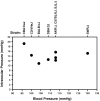Intraocular pressure in genetically distinct mice: an update and strain survey
- PMID: 11532192
- PMCID: PMC48141
- DOI: 10.1186/1471-2156-2-12
Intraocular pressure in genetically distinct mice: an update and strain survey
Erratum in
- BMC Genet. 2001;2(1):16.
Abstract
Background: Little is known about genetic factors affecting intraocular pressure (IOP) in mice and other mammals. The purpose of this study was to determine the IOPs of genetically distinct mouse strains, assess the effects of factors such as age, sex and time of day on IOP in specific strain backgrounds, and to assess the effects of specific candidate gene mutations on IOP.
Results: Based on over 30 studied mouse strains, average IOP ranges from approximately 10 to 20 mmHg. Gender does not typically affect IOP and aging results in an IOP decrease in some strains. Most tested strains exhibit a diurnal rhythm with IOP being the highest during the dark period of the day. Homozygosity for a null allele of the carbonic anhydrase II gene (Car2n) does not alter IOP while homozygosity for a mutation in the leptin receptor gene (Leprdb) that causes obesity and diabetes results in increased IOP. Albino C57BL/6J mice homozygous for a tyrosinase mutation (Tyrc-2J) have higher IOPs than their pigmented counterparts.
Conclusions: Genetically distinct mouse strains housed in the same environment have a broad range of IOPs. These IOP differences are likely due to interstrain genetic differences that create a powerful resource for studying the regulation of IOP. Age, time of day, obesity and diabetes have effects on mouse IOP similar to those in humans and other species. Mutations in two of the assessed candidate genes (Lepr and Tyr) result in increased IOP. These studies demonstrate that mice are a practical and powerful experimental system to study the genetics of IOP regulation and disease processes that raise IOP to harmful levels.
Figures










Similar articles
-
Intraocular pressure in zebrafish: comparison of inbred strains and identification of a reduced melanin mutant with raised IOP.Invest Ophthalmol Vis Sci. 2004 Dec;45(12):4415-22. doi: 10.1167/iovs.04-0557. Invest Ophthalmol Vis Sci. 2004. PMID: 15557450
-
Noninvasive determination of intraocular pressure (IOP) in nonsedated mice of 5 different inbred strains.J Glaucoma. 2007 Jan;16(1):57-61. doi: 10.1097/IJG.0b013e31802b3547. J Glaucoma. 2007. PMID: 17224751
-
Dependency of intraocular pressure elevation and glaucomatous changes in DBA/2J and DBA/2J-Rj mice.Invest Ophthalmol Vis Sci. 2008 Feb;49(2):613-21. doi: 10.1167/iovs.07-0745. Invest Ophthalmol Vis Sci. 2008. PMID: 18235006
-
The genetics of intraocular pressure.Semin Ophthalmol. 2013 Sep-Nov;28(5-6):301-5. doi: 10.3109/08820538.2013.825291. Semin Ophthalmol. 2013. PMID: 24138038 Review.
-
[A challenge to primary open-angle glaucoma including normal-pressure. Clinical problems and their scientific solution].Nippon Ganka Gakkai Zasshi. 2012 Mar;116(3):233-67; discussion 268. Nippon Ganka Gakkai Zasshi. 2012. PMID: 22568103 Review. Japanese.
Cited by
-
Mice with an induced mutation in collagen 8A2 develop larger eyes and are resistant to retinal ganglion cell damage in an experimental glaucoma model.Mol Vis. 2012;18:1093-106. Epub 2012 May 1. Mol Vis. 2012. PMID: 22701298 Free PMC article.
-
AMP-activated protein kinase regulates intraocular pressure, extracellular matrix, and cytoskeleton in trabecular meshwork.Invest Ophthalmol Vis Sci. 2014 Apr 8;55(5):3127-39. doi: 10.1167/iovs.13-12755. Invest Ophthalmol Vis Sci. 2014. PMID: 24713487 Free PMC article.
-
TLR4 deficiency does not alter glaucomatous progression in a mouse model of chronic glaucoma.Sci Rep. 2025 May 15;15(1):16852. doi: 10.1038/s41598-025-00638-7. Sci Rep. 2025. PMID: 40374644 Free PMC article.
-
Vitamin B3 modulates mitochondrial vulnerability and prevents glaucoma in aged mice.Science. 2017 Feb 17;355(6326):756-760. doi: 10.1126/science.aal0092. Science. 2017. PMID: 28209901 Free PMC article.
-
A Comprehensive Protocol for Microbead-Induced Ocular Hypertension in Mice.Methods Mol Biol. 2025;2858:243-264. doi: 10.1007/978-1-0716-4140-8_20. Methods Mol Biol. 2025. PMID: 39433681
References
-
- Leske MC. The epidemiology of open-angle glaucoma: a review. Am J Epidemiol. 1983;118:166–191. - PubMed
-
- Ritch R, Shields MB, Krupin T. The Glaucomas, Clinical Science, 2nd edn St Louis, MO: Mosby-Year Book; 1996.
-
- Shields MB. Textbook of Glaucoma, Third edn Baltimore: Williams & Wilkins; 1992.
-
- Epstein DL, Allingham RR, Schuman JS. Chandler and Grant's Glaucoma, Fourth edn Baltimore, Maryland: Williams and Wilkins; 1997.
Publication types
MeSH terms
Substances
Grants and funding
LinkOut - more resources
Full Text Sources
Other Literature Sources
Molecular Biology Databases
Miscellaneous

